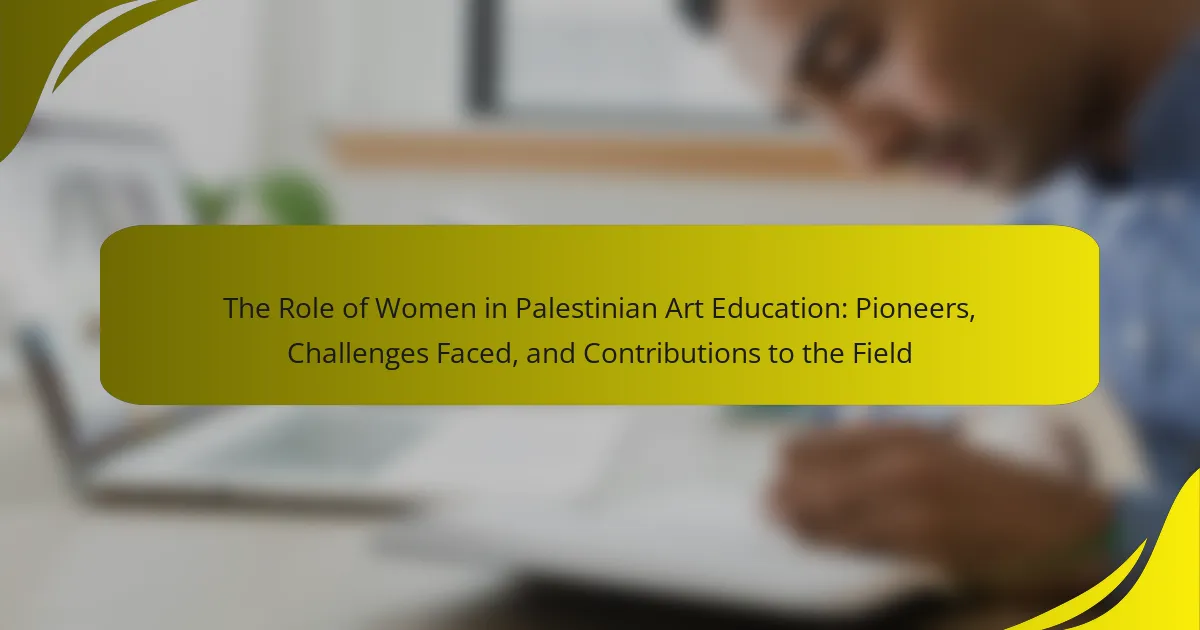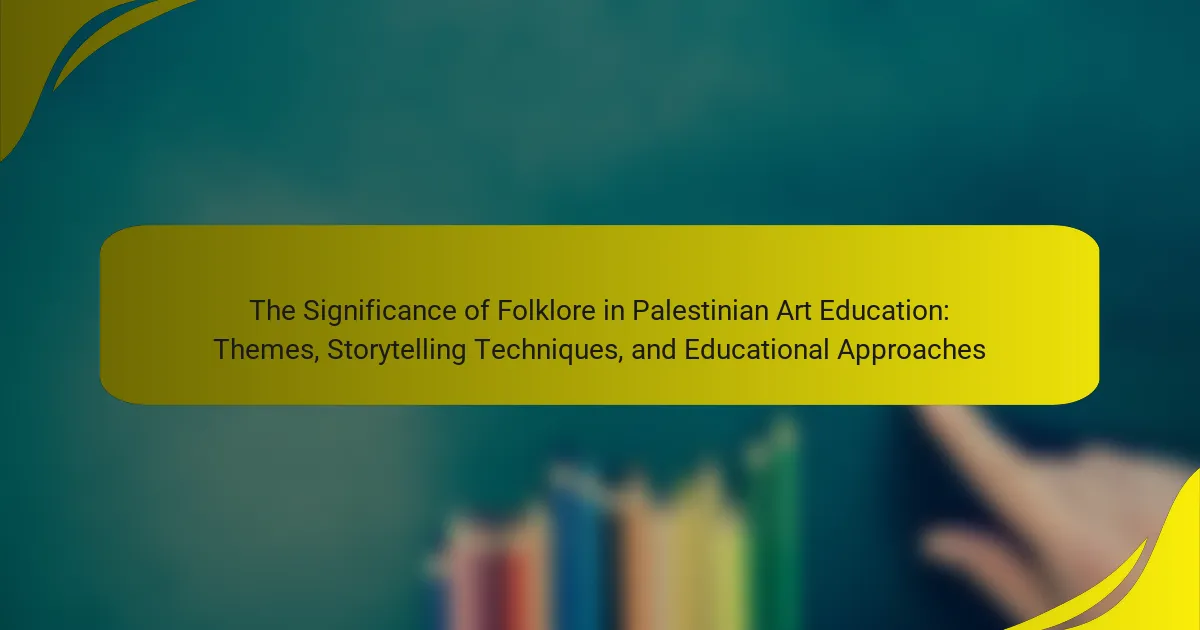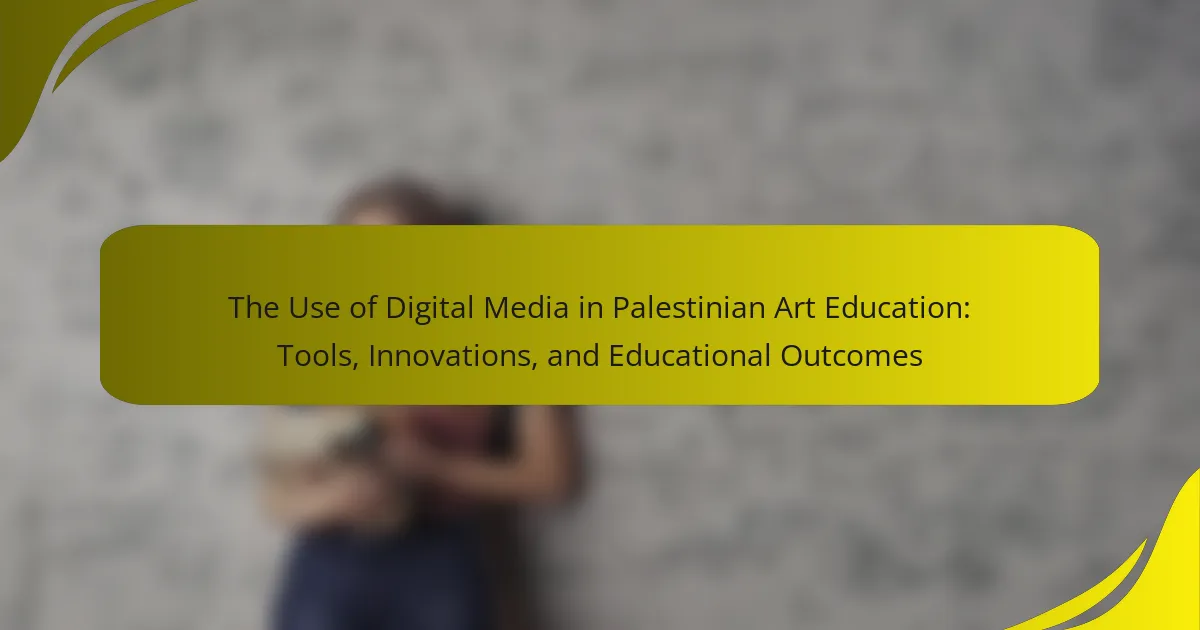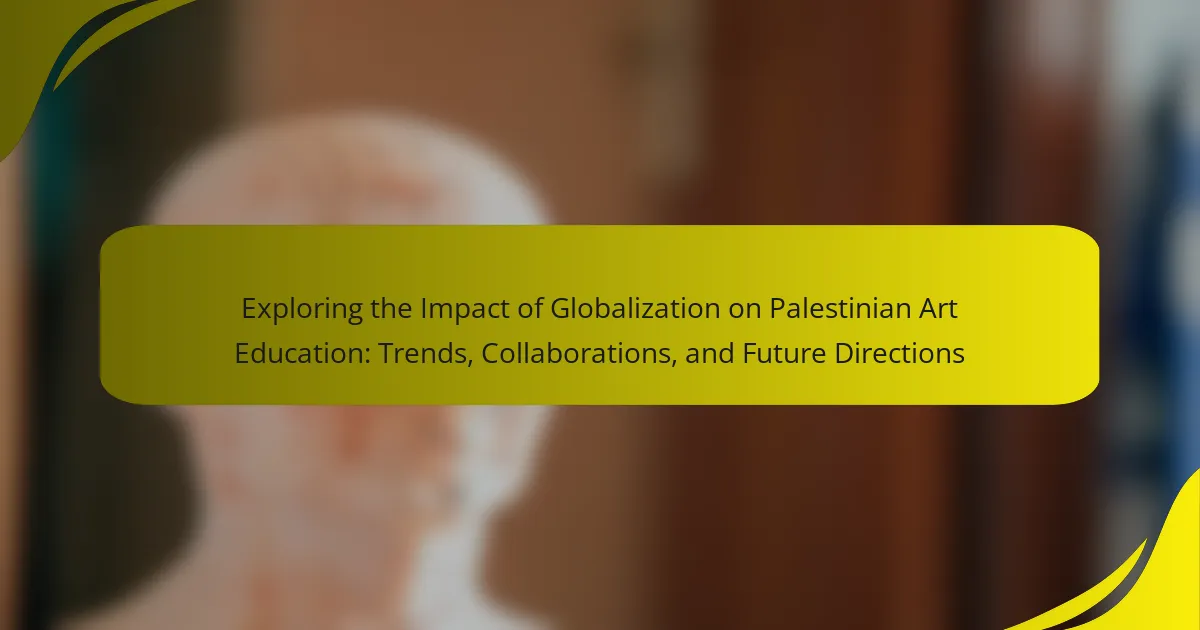The article examines the intersection of identity and art education in Palestine, highlighting how art serves as a vital medium for expressing cultural narratives. It explores how art education enables Palestinians to convey their historical and social experiences, fostering identity through various artistic forms, including visual arts, music, and literature. The discussion emphasizes themes of resistance and resilience, reflecting the socio-political challenges faced by the community. Additionally, it addresses how incorporating local history and culture into art curricula empowers students, enhances critical thinking, and nurtures a sense of belonging and personal development among young Palestinians.
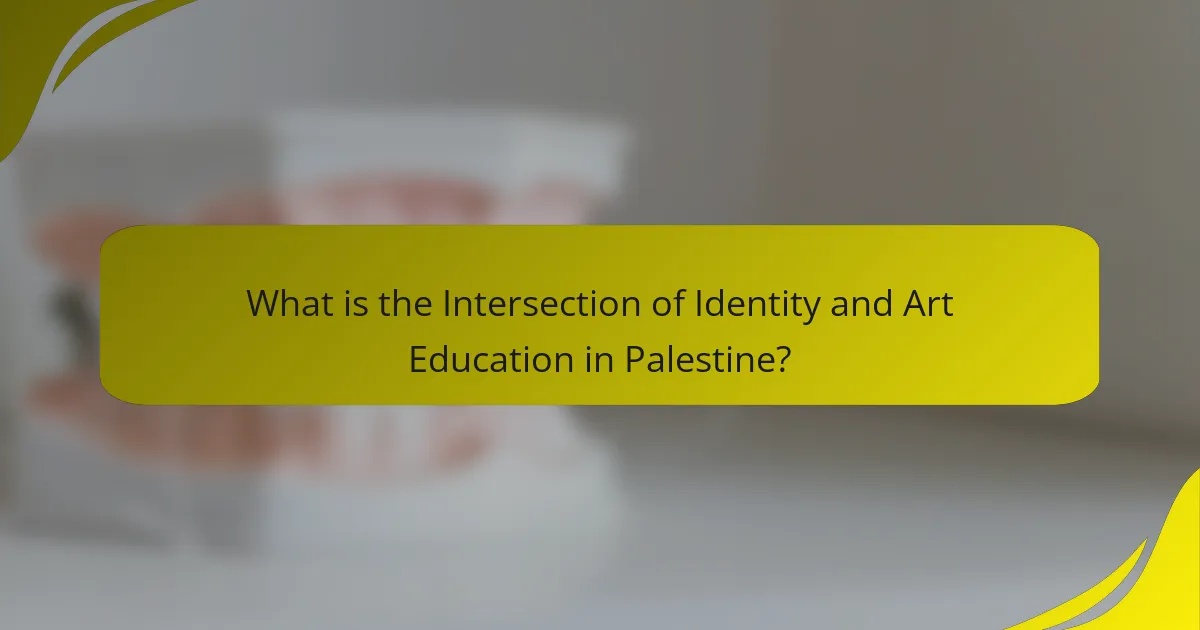
What is the Intersection of Identity and Art Education in Palestine?
The intersection of identity and art education in Palestine revolves around the expression of cultural narratives. Art education serves as a medium for Palestinians to convey their historical and social experiences. It facilitates the exploration of identity through creative practices. This intersection is evident in various forms of artistic expression, including visual arts, music, and literature.
Art education in Palestine often integrates themes of resistance and resilience. It reflects the ongoing socio-political challenges faced by the community. Through art, students engage with their heritage and collective memory. This engagement fosters a sense of belonging and identity among young Palestinians.
Research indicates that art education can empower students to articulate their experiences. It provides a platform for dialogue and discussion about identity. The incorporation of local history and culture in curricula enhances relevance. This approach nurtures critical thinking and creativity in students.
Overall, the intersection of identity and art education in Palestine is significant for cultural representation and personal development.
How does identity influence art education in Palestine?
Identity significantly influences art education in Palestine by shaping the themes and expressions within the curriculum. Palestinian identity is often reflected in art through historical narratives, cultural symbols, and social issues. This connection enhances students’ understanding of their heritage and fosters a sense of belonging.
Art educators incorporate local traditions and contemporary struggles into their teaching. This approach encourages students to explore their identity creatively. Research shows that art serves as a medium for resistance and self-expression in Palestinian society. For example, the work of artists like Emily Jacir highlights the intersection of identity and art in the Palestinian context.
Moreover, art education in Palestine often addresses topics of displacement and resilience. This focus allows students to engage with their history and cultural identity. Therefore, identity plays a crucial role in shaping the content and pedagogical practices of art education in Palestine.
What cultural narratives shape artistic expression in Palestinian society?
Cultural narratives that shape artistic expression in Palestinian society include themes of resistance, identity, and heritage. The ongoing conflict with Israel influences many artists to depict struggles and resilience. Artistic expressions often reflect the Palestinian experience of displacement and longing for homeland. Traditional motifs and symbols are frequently used to convey cultural identity. The narratives are also informed by historical events, such as the Nakba of 1948. These events foster a collective memory that artists draw upon. Additionally, gender roles and women’s experiences shape narratives in contemporary art. This intersection of personal and political storytelling defines much of Palestinian artistic expression.
How does the historical context of Palestine affect art education?
The historical context of Palestine significantly influences art education. Political turmoil and conflict have shaped cultural narratives and artistic expression in the region. Restrictions on movement and access to resources impact the availability of art materials and educational opportunities. The ongoing occupation affects the curriculum and pedagogical practices in art education. Artists often use their work to express identity and resistance, reflecting the socio-political landscape. Historical events, such as the Nakba, are integral to understanding Palestinian art. This context fosters a unique blend of traditional and contemporary artistic practices. Consequently, art education in Palestine is a means of preserving cultural heritage and promoting social change.
What role does representation play in Palestinian art education?
Representation plays a crucial role in Palestinian art education. It shapes students’ understanding of their identity and cultural heritage. Through representation, art education reflects the diverse narratives of Palestinian society. This inclusion fosters a sense of belonging among students. It also empowers them to express their experiences creatively. Research shows that representation in art can enhance critical thinking skills. Moreover, it promotes dialogue about social and political issues. The incorporation of local artists’ works in curricula is essential for this purpose. Overall, representation enriches the educational experience by validating students’ voices and perspectives.
How are diverse identities represented in Palestinian art curricula?
Diverse identities in Palestinian art curricula are represented through various artistic expressions that reflect cultural, social, and political narratives. The curricula incorporate themes of identity, heritage, and resistance. This representation includes visual arts, literature, and performance, showcasing the complexities of Palestinian identity. For instance, students explore traditional motifs alongside contemporary issues affecting their communities. The integration of diverse voices in the curricula emphasizes inclusivity and social justice. Art educators encourage critical thinking about identity through projects that engage with local histories and global contexts. This approach fosters an understanding of the multifaceted nature of Palestinian identity.
What are the implications of representation for students’ self-identity?
Representation significantly impacts students’ self-identity. When students see themselves reflected in educational materials, they develop a stronger sense of belonging. This visibility fosters positive self-esteem and confidence. Conversely, lack of representation can lead to feelings of alienation and diminished self-worth. Research indicates that diverse representation in curricula enhances students’ engagement and motivation. For example, studies show that students who identify with characters in literature perform better academically. Thus, representation shapes how students perceive themselves and their potential in society.
What pedagogical practices are utilized in art education in Palestine?
Art education in Palestine employs various pedagogical practices that emphasize cultural narratives and identity. These practices include project-based learning, where students engage in community-oriented art projects. Collaborative learning is also prevalent, encouraging students to work together and share perspectives. Critical pedagogy is utilized to foster discussions about identity and social issues through art. Additionally, reflective practices are incorporated, allowing students to analyze their work and its cultural significance. Hands-on workshops and traditional art forms are emphasized to connect students with their heritage. These approaches aim to empower students and enhance their understanding of their cultural context.
How do teachers incorporate cultural narratives into their art lessons?
Teachers incorporate cultural narratives into their art lessons by integrating local history and traditions into the curriculum. They utilize artworks from Palestinian artists to provide context and inspiration. Lessons often focus on themes of identity, community, and resistance. Teachers encourage students to create art that reflects their personal and cultural experiences. This approach fosters a deeper understanding of their heritage. Research shows that culturally relevant pedagogy enhances student engagement and creativity. For example, the work of authors like Ladson-Billings emphasizes the importance of cultural relevance in education. By connecting art to cultural narratives, teachers create a meaningful learning environment.
What innovative methods are used to engage students in art education?
Innovative methods used to engage students in art education include collaborative projects, digital art tools, and community-based art initiatives. Collaborative projects foster teamwork and creativity among students. They encourage sharing diverse perspectives and cultural narratives. Digital art tools, such as graphic design software, enhance student engagement through interactive learning. These tools allow students to experiment with their artistic expression. Community-based art initiatives connect students with local artists and cultural heritage. This approach promotes a sense of belonging and identity. Research shows that these methods improve student motivation and learning outcomes in art education.
How do cultural narratives connect identity and art education in Palestine?
Cultural narratives in Palestine connect identity and art education by reflecting the collective experiences and histories of the Palestinian people. These narratives serve as a foundation for artistic expression, allowing students to explore their cultural heritage. Art education incorporates themes of resistance, resilience, and identity, which are central to Palestinian culture. Through various artistic mediums, students engage with their identity and express their perspectives. For instance, traditional art forms, such as embroidery and calligraphy, are taught to preserve cultural practices. This educational approach fosters a sense of belonging and community among students. Moreover, art education encourages critical thinking about social and political issues affecting Palestinian identity. By integrating cultural narratives, art education becomes a tool for empowerment and self-representation. This connection enhances students’ understanding of their identity in a broader socio-political context.
What challenges do educators face in conveying identity through art education?
Educators face several challenges in conveying identity through art education. One challenge is the lack of resources for diverse artistic expressions. Many schools in Palestine have limited access to art supplies and materials. This restricts students’ ability to explore their cultural identities through various art forms.
Another challenge is the political context affecting education. Ongoing conflict and instability can hinder the implementation of art programs. Educators may struggle to create safe environments for self-expression.
Additionally, there may be a lack of teacher training focused on identity representation. Many educators are not equipped with the necessary skills to facilitate discussions about identity through art. This gap can lead to missed opportunities for students to engage with their cultural narratives.
Furthermore, societal expectations can impose limitations on artistic expression. Students may feel pressure to conform to dominant narratives rather than explore their unique identities. This can stifle creativity and personal expression in the classroom.
Overall, these challenges create a complex landscape for educators trying to convey identity through art education in Palestine.
What are the best practices for integrating identity and art education in Palestine?
Integrating identity and art education in Palestine involves several best practices. First, curricula should include local cultural narratives. This approach fosters a sense of belonging among students. Second, collaborative projects between artists and educators can enhance learning experiences. These partnerships can provide practical insights into contemporary issues. Third, incorporating community engagement is essential. Involving local communities can enrich the educational context and relevance. Fourth, promoting critical thinking through art can empower students. This method encourages them to express their identities and perspectives. Finally, utilizing diverse art forms can cater to various learning styles. This inclusivity can enhance participation and understanding. These practices collectively support a holistic educational framework that respects and promotes Palestinian identity through art.
The main entity of the article is the intersection of identity and art education in Palestine. The article explores how art education serves as a medium for Palestinians to express their cultural narratives, reflecting themes of resistance, resilience, and identity. It discusses the influence of historical context on art education, the importance of representation in shaping students’ self-identity, and the pedagogical practices that educators employ to integrate local cultural narratives. Additionally, it addresses the challenges faced by educators in conveying identity through art and outlines best practices for enhancing art education in Palestine.
